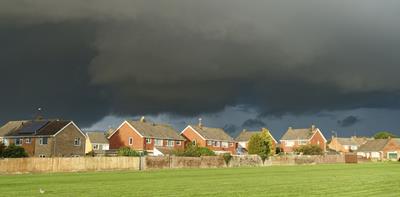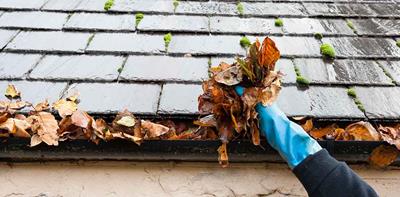
From heavy rain to strong winds and even hail or deep snow, the UK’s changeable weather can take a toll on our homes.
Here we look at the potential storm risks faced by UK homes, and tell-tale signs that your property has been affected.
What counts as a storm?
To qualify as a storm for insurance purposes, the weather needs to meet one or more of the following conditions[1]:
- Wind gusting at 48 knots (55mph) and above
- Heavy rainfall with a rate of at least 25mm per hour
- Snow falling to a depth of at least one foot (30cm) in 24 hours
- Hail which can break glass or cause damage to hard surfaces
We’ll consider each weather event in turn.
Strong winds
The UK experiences strong winds and storms throughout the year, especially in coastal areas. In February 2022, Storm Eunice brought the highest recorded wind speed in England – 122mph at the Needles on the Isle of Wight[2].
High winds can cause damage to roofs, fences and external structures. Signs of wind-related problems include loose, cracked or missing roof tiles, damaged chimney pots, cracked brickwork and crumbling mortar.
You may also have garden damage such as fallen branches or leaning trees. It’s always best to clear fallen branches as soon as it’s safe to do so, as these can cause further damage to property if the wind picks up again.
Regular maintenance of your property – including trimming trees and securing loose objects – can help mitigate the impact of strong winds.
Find out how to protect your home from high winds here.
Heavy rain and flooding
Anybody who lives in the UK is accustomed to heavy rain, especially in autumn and winter. But the regular deluges are more than just a conversation starter. Excessive rain periodically causes surface flooding, which can seriously damage homes.
If a property is ever affected by flooding, it can become difficult to sell on, or get home insurance. It’s also an incredibly stressful experience.
If you’re not sure of your property’s flood-risk status, it’s a good idea to look into it. It’s worth doing this for ground-level buildings even if there’s no obvious risk, for example nearby waterways.
You can check a property’s flood risk in:
To identify potential problems, look for signs outdoors such as water pooling around your property, blocked or dripping gutters, or overflowing drains. It’s important to check your gutters and downpipes regularly to ensure they're functioning properly, and free from debris.
Inside, keep an eye out for damp patches on walls or ceilings, and water seeping through doors or windows. If you have one, you can also check your attic for signs of water ingress from the roof. Also, pay attention to musty odours or a sudden increase in insect activity. These could indicate hidden moisture-related issues.
Find out how to protect your home from flooding here.
Freezing temperatures, snow, ice and hail
Cold winters can bring freezing temperatures and ice, posing risks to homes. One of the most significant concerns is frozen pipes, which can burst. This can then cause extensive water damage when they thaw.
Look out for signs such as reduced water flow, strange noises from pipes or visible cracks. It’s best to insulate exposed pipes, which is also more energy-efficient. We have more detailed advice in our guide on how to reduce the risks posed by frozen or bust pipes.
Heavy snow can cause problems too, such as by weighing down on your home’s less sturdy features, such as guttering. But the real problems come when snow starts to melt. Keep your eyes peeled for ice dams on your roof – which is when ice gathers in your guttering, forming icicles. This can trap water, leading to seepage and damage.
If your home has been pelted by hail, similarly to strong winds, it’s worth checking the roof, guttering, brickwork and chimney pots. Also, check vulnerable items in the garden, such as your shed and fencing.
For more information about how to protect your home and belongings, go to Solved.
[1] https://www.abi.org.uk/products-and-issues/topics-and-issues/flooding/storms/
[2] https://www.independent.co.uk/news/uk/storm-eunice-uk-wind-speeds-gust-b2018249.html


